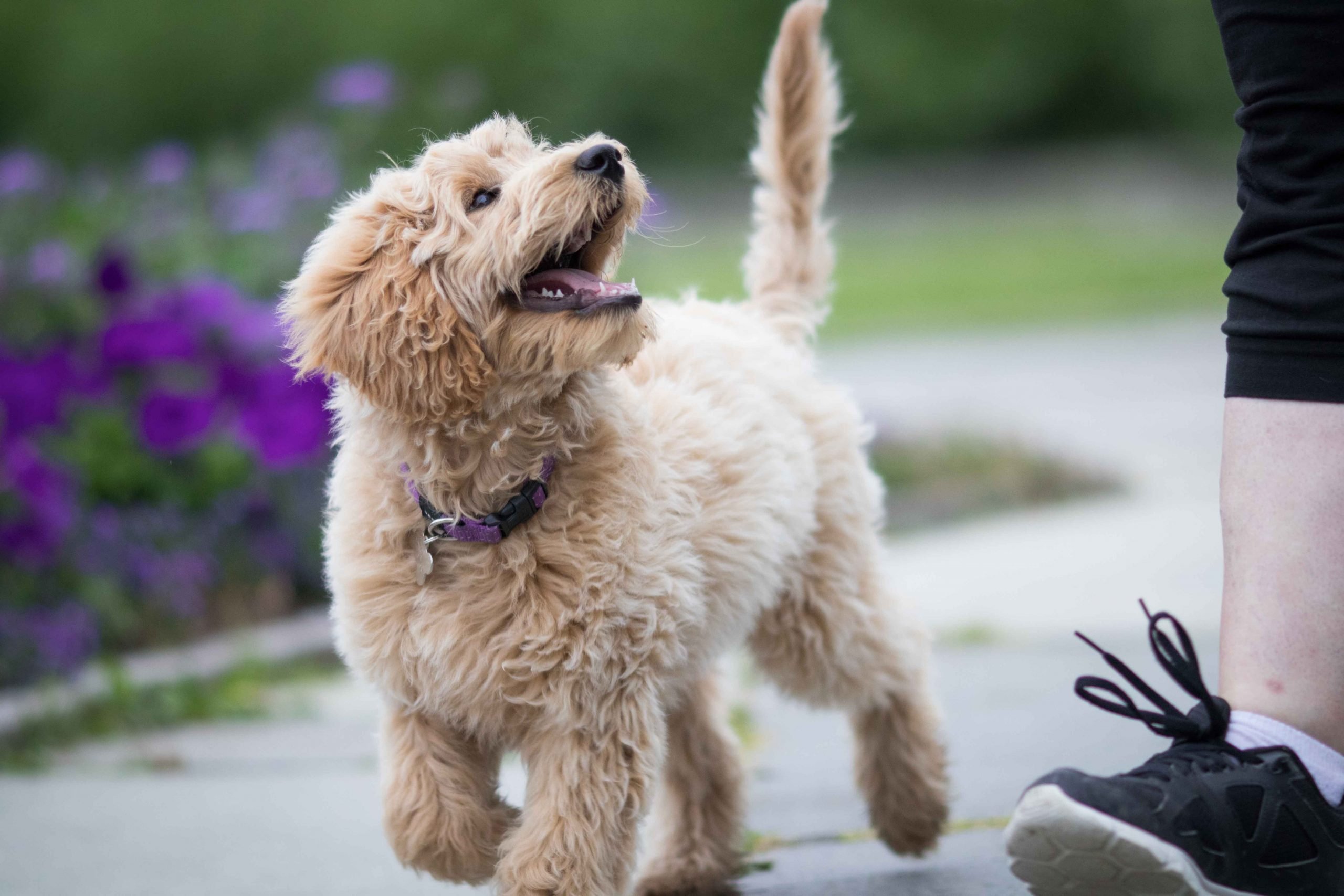This page contains affiliate links. This means that we may get a small commission for recommending products, if you choose to click on something and buy it. This does not cost you anything, but we wanted to be honest and let you know!
(Last Updated On: 6th August 2022)Labradoodles are very smart dogs, and if you don’t know how to train your Labradoodle, they will get the best of you in most situations.
Every dog, including Labradoodles, needs exercise, discipline, and affection. Every owner needs to train their pet and have patience during the training process.
Here are some tips to help when you are learning how to train your Labradoodle puppy.
Table of Contents
Labradoodle House Training
Before you bring you little ball of energy home, make sure that your house is puppy and dog-proofed.
Put anything potentially dangerous where these curious creatures will not be able to get at it.
Much like you would do for a baby or toddler, you will want to secure cords that they could become tangled in and place breakables out of reach.
Labradoodles Love Fenced in Yards
There is not a dog in the world that wants to be forever on a leash. Labradoodles are curious and love to explore at their own pace.
They also love running and jumping and rolling in the grass. Trying to have fun while being always restrained is frustrating for all concerned.
Part of the investment you make when choosing to become a pet owner is to provide for the safety and enjoyment of life.
All that can happen right in your own backyard, as long as you have a fenced yard.
Start Training Your Labradoodle Right Away
You will not enroll your month’s old Labradoodle in an obedience class, but you can set boundaries while your pup is settling into their new home.
Doing so will make them feel more confident in their new surroundings.
It is better for all concerned that the rules are set out, as it will make the times they get into trouble happen less frequently.
Begin with just basic commands given with the right measure of patience and firmness.
There is a lot to learn when you are just weeks old, and everything is new and exciting, so patience is a must!
Positive Reinforcement is The Best Way to Train Your Labradoodle
Knowing how to train a Labradoodle before you bring one home is the best course of action.
Your Labradoodle will respond best to positive reinforcement. It is never a good idea to use fear or intimidation to train your doodle or any other breed of dog.
The training process is also a time for bonding and gaining your puppy’s trust. Reward your doodle for good behavior and correct or ignore bad behavior.
Treats, praise, using a clicker for training, all of that will reward them for doing a good job and make them want to do more.
Positive reinforcement will take more patience, but it will help to form a bond that will be lifelong.
Tailor Your Training to Your Labradoodle’s Environment
Every home and environment is different.
While a general rule is that you should always have your pup sit before going out the door, there will be certain rules that are specific to your home and their environment.
If you live alone, the play rules will be different from if it was a household with children.
Set the guidelines from the very beginning so that there is a clear understanding of the rules.
Decide beforehand if you will allow your pet to be on the furniture or if they will be allowed to sit under the table at dinnertime.
There will be a certain amount of “learning on the job”, but for the most part determine your rules before bringing home your new pup.
Always, Always be Consistent
Once you decide on a rule, be consistent. There would be nothing more confusing than to have the rule enforced on Monday but not on Tuesday and so on.
While you can modify your rules as needed, if nipping on Wednesday is not allowed, it should be wrong the rest of the days too.
If you are not consistent in your training, you will end up with a confused pooch that is far less likely to follow any of the rules.
Labradoodle Crate Training
Make the crate a place that your doodle does not mind being in. Have some soft padding or cozy blanket and toys in the crate to keep them company.
When purchasing a crate, get one that your pup will grow into.
While it might be hard to know exactly how big your pooch will get, the breeder or person you purchase from should be able to give you an idea of how big the parents were.
Choose a crate that will accommodate the length and height when sitting of your pet.
The time they spend in the crate should not exceed their age in months plus one hour. So if your pup is two months old, they should not be kept in a crate over three hours.
Labradoodle Potty Training
This can be a dreaded task, and not always a pleasant one, but it comes with the territory. Potty training can be another opportunity to bond and reward your pet for a job well done.
The key to this process is consistency. Let your pup out at the same time each day, and take them to the same spot each time.
They will need to go out when they first get up after eating and drinking and before they go to sleep at night.
In the beginning, they are going to need to go more often, so just be mentally prepared for the process.
Decide on a word that you will use from here on out for your pup to associate with going to the bathroom.
Repeat that word when you are taking them outside to do their business. When they get it right, make sure to give them praise.
Just as you had to learn and had slip-ups, so too will your pup need to learn, and they will definitely have slip-ups.
It is all part of the learning process. Clean up what you need to and give lots of praise when they get it right. They will eventually get it right most all the time.
Train Your Labradoodle to Socialize And Have Manners
You love your new Labradoodle pup, and you want others to love them, too.
The majority of dogs are social by nature, and doodles are the happiest when they are with other dogs and people.
The best thing you can do to make sure that your fur baby grows up to be a social and friendly creature is to expose them to other pets and people.
This should happen at places other than your own home. Your pooch needs to be able to know how to act in a variety of situations, like on a walk, at the beach or when a guest at someone else’s house.
Take them out as much as possible to get them accustomed to different sights, sounds, and places.
If you doodle starts to develop any bad habits like jumping on you, you will want to stop that behavior when they are young.
It is harder to change habits when a dog gets older, helping them when they are still learning how to mind their manners.
In Conclusion
A Labradoodle will be a wonderful addition to your life. Knowing how to train a Labradoodle will be essential to achieving a happy, balanced relationship with your pet.
The best advice of all is to have patience. Labradoodles love to please, so give them time to learn and grow.
You will be able to look forward to a lifetime of companionship with your new best bud!
Ian is an avid outdoorsman and dog lover. He lives in Central Florida with his wife Heather, and their 2 dogs – Panda (Purebread Rough Collie X English Golden Retriever) & Kuma (Blue Merl Purebread Rough Collie)








